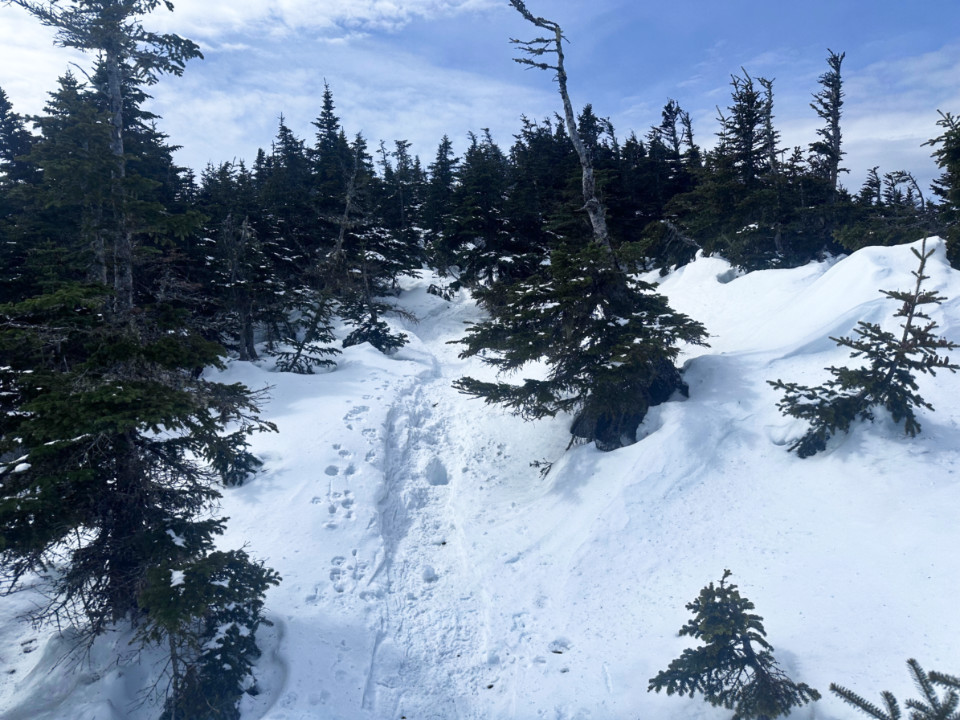April is the hardest month to climb 4000 footers in the White Mountains because winter conditions often prevail past the end of calendar winter. More often than not, there’s at least one major winter storm that hits the region in late March or early April to add to the snowpack and prolong the winter hiking season for a month or more. Only with the warming temperatures of spring, the snow turns to mashed potatoes and the rivers rise, further complicating efforts to climb many peaks, especially the ones deep inside wilderness areas.
I took a break from climbing 4000 footers in February and March this year because I’d already completed the 4000 footers I needed to hike in that month for The Grid, an uber 4000 footer list where you’re required to hike all 48 of the four thousand footers in each calendar month 12 x 48 for a total of 576 summits (most people take several years to finish). That condition is known as being “grid-locked” amongst the “gridiots” who have completed or are pursuing this insane peakbagging list.
But I had 9 peaks left to finish in April, so when April 1st came around I was out to climb the first one, Carter Dome, the 9th highest 4000 footer with an elevation of 4832′. It was to be my 12th month climbing the peak, known as “gridding-it-out”. I always like to bag a peak on the 1st of the month, weather permitting, because you can’t climb many of the peaks in bad weather. That’s one reason why The Grid is so difficult to complete. It takes pretty dogged persistence to climb all 48 during the months when the weather is challenging.

I was a little unsure of my stamina before this hike because I’d been taking it easy the prior 2 months, climbing some smaller winter peaks in Vermont, learning to dance the Tango, and taking pilates and yoga classes. But I’ve hiked Carter Dome many times and knew that it usually takes me 6 hours to hike the 9.6 mile round trip with 3,000 feet of elevation gain. I needn’t have worried: while my quads were sore the next day, I climbed the peak about 20 minutes faster than usual, even in winter conditions with deep snow.
What surprised me though, was how much damn snow there still is at elevation in the Whites. The white and blue Appalachian Trail blazes painted on trees, which are usually at eye-level or head height, were almost buried under the snow pack. This was due to a late March storm that dumped several feet of snow onto the high peaks, which happens every year like clockwork. This week, another storm dumped 2-3 feet of additional snow on top of that, so we’ll have to contend with snow into May.
Lower down, spring is on the way, or it was until this latest storm. Segments of the trails are down to mud and rock with snowmelt flowing down them. The rivers and streams are flowing free and the early trout fishing season is about to kick off. Despite that, if you want to go high, you still need to carry snowshoes, extra insulation, and wind protection against the bitter cold.

Despite the snow depth, trail conditions were good and I was able to complete the hike with just Hillsound Trail Crampons instead of snowshoes, although they were strapped to my back. I’d gotten an early start because it still drops below freezing at night and the trails are harder in the morning. But the trails were softening on my descent and would have turned to mashed potatoes had I gotten a later start. When that happens, it’s just easier to wear snowshoes than spikes and it’s better etiquette because you don’t create postholes in the trail surface.
I was happy when I got back to the trailhead and took stock of the hike. I hadn’t lost my stamina during my time off, which is important because I have some big ass hikes remaining in April out to the Bonds and the Twins/Galehead which can be arduous slogs in soft slow. With Carter Dome in the can, I was 97.6% done with The Grid and only have 13 summits left to finish, hopefully this May 2024.
